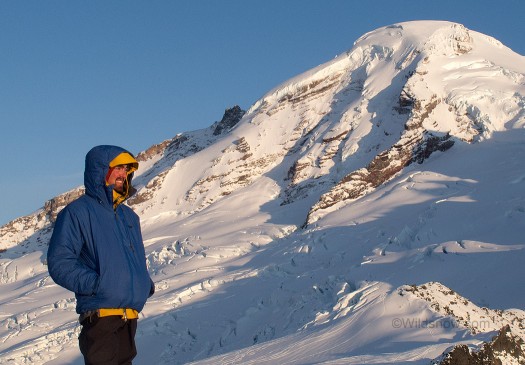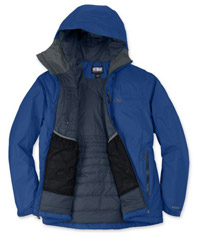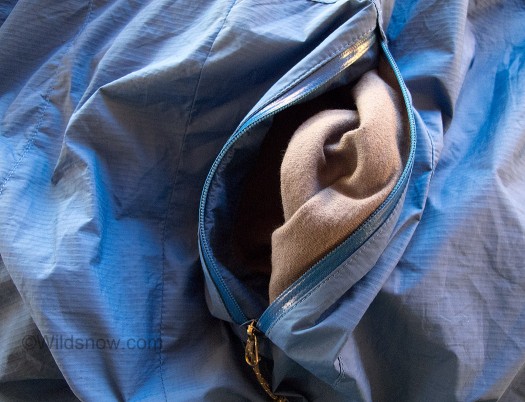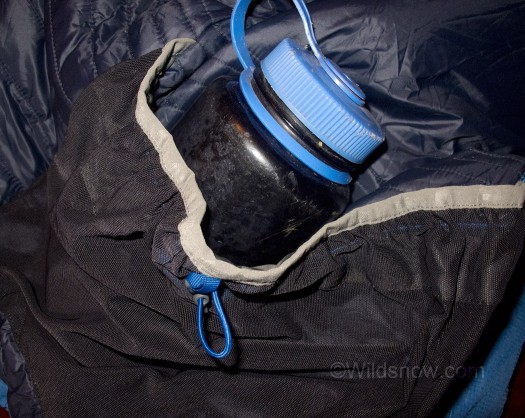Goose down and I don’t have a good relationship, or much of any relationship for that matter. I don’t I own a single piece of feather filled gear that I use on a regular basis.
Maybe this is illogical bias indoctrinated from a young age, but I don’t think I’ll ever change. Not only do synthetics retain their insulation when wet, they have been loosing weight at a rapid pace over the last few years.
But down is light. Isn’t this Wildsnow? Where light is right? You might have a point, but down is not as light as you think.
For one thing, the smaller piece of gear you have, the smaller the weight difference (there’s that 3rd grade arithmetic coming in handy). Down and synthetic booties are virtually identical in mass. When you move up to a jacket, the weight difference becomes measurable, but not significant. The Outdoor Research (OR) Chaos Jacket (billed as a belay parka) weighs 25.4 oz, while OR’s down belay parka, the Maestro, is 2.5 oz lighter. Hardly something to dance in the streets about.
With something like a sleeping bag the weight becomes more significant, but not extreme. Besides, any down-wearer worth his feathers knows that you should keep your jacket in a drybag worthy stuffsack, which adds at least an ounce, inching your feathers even closer to their heavyweight rival.
Perhaps most importantly, once down absorbs just a tiny bit of moisture (as it is prone to do), all difference between it and the mass of synthetic fill is gone gone gone. In fact, it can even end up heavier, as folks packing sodden down sleeping bags can attest to. Along those same lines, try drying a down sleeping bag or jacket once it’s soaked. Nearly impossible in the field, while you can hang your synthetic on a tree in the sun and it’ll quickly lose any residual moisture.
So there, feathers aren’t that light. And to top that, synthetics have more advantages. As a Ramen-eating, bike-riding college student, I appreciate the fact that synthetics are a smaller blow to the bank account (though technical gear such as this still ain’t cheap). If you rip a hole in a synthetic jacket, you don’t have to worry about your precious insulation cascading out like water from a punctured Camelbak. And lastly, no mater how hard you try, in the mountains your gear will get wet at some point, whether it’s condensation from your water bottle in your pack, sweat when your hiking, or spindrift that’s blowing a million directions at once. Covering up with a hardshell works in mellow weather, but in the alpine snow always creeps in. Bottom line: unless you care for your down garment fastidiously, and are using it in relatively dry conditions, eventually you’ll end up with (to put it politely) “two wet plastic bags with a few feathers in between.”
And yes, down fans, the puffy feathers do have a few things going for them. Down (if properly cared for) will continue to insulate for years after a synthetic jacket has turned into a flat, cold version of it’s former self. And it sure compresses nicely for packing. To me, those things mean little.
Admit it, you’ll be buying the newest and greatest jacket in a few years either way, so what does fill longevity have do do with it? And does wadding your jacket into a tiny stuff sack really reveal the meaning of life?
Probably the most significant “advantage” of feathers (at least for the average shopper), is that when you try on a down jacket in a store, it envelopes you in a thick, puffy embrace that instantly has you overheating and whipping out the wallet. While the lowly synthetic sits, thin and shapeless, on a rack, waiting for an intelligent mountaineer to reward with warmth during some abysmal Cascade downpour.
Whew! Now that I got that off my chest, we can move on to the review:
I tend to carry one big puff jacket at the bottom of my pack. I don’t pull it out very often, but when I do, I cherish it. My previous one was a thrift shop-score Patagonia that I got when I was starting high school, so it was time for a replacement.
The OR Chaos Jacket seemed like a good choice. It’s OR’s warmest synthetic insulated jacket (Primaloft Eco), with a shell made of Windstopper fabric. A hood and several pockets round out the feature set.
The jacket uses strategically placed Primaloft Eco. It has 133 grams in the body, 100 grams in the sleeves, and 60 grams in the hood. I wasn’t sure how this “body mapping” would work at first. I’m now impressed. While hoods provide useful additional warmth on the head, they also are extra weight and bulk that doesn’t get used that often, especially since I wear a helmet much of the time. The lighter insulation in the hood keeps the weight down, but provides a bit of insulation when needed, as well as “connecting” the heat from the head to the rest of the body. I haven’t noticed my arms getting overly cold due to their lesser insulation, and am grateful for the generous insulation in the main body, as one issue with puff jackets is they frequently are too thin, placing style over function. During one recent cold night out, I wore the Chaos inside my sleeping bag. I slipped my arms into the main jacket body, and toasted like a burning bagel all night, even in 30 mph wind and snow. (Please don’t ask me how I know about burning bagels.)
The Gore Windstopper shell is another welcome feature. Indeed, every puff jacket made should have something like this. The Windstopper not only cuts down significantly on convective heat loss, but provides a bit of water resistance as well that’s noticeably better than just having DWR treated porous nylon as a shell. Many core users like to throw their puffy over everything during breaks, and in wet conditions, that means you need some water resistance.
I like pockets, and I tend to keep an arsenal of snacks and other odds and ends in them during a ski tour. The Chaos has a nice assortment. Two fleece lined handwarmer pockets, exterior and interior “napoleon” pockets, and two massive interior mesh pockets. The handwarmer pockets are nice for warming the digits (go figure). I don’t use the napoleon pockets much, but the mesh pockets are incredible. In my opinion every jacket should be made with these, as they add marginal weight, and have a ton of uses. I use them for storing hats, gloves, and water bottles in a warm place. OR’s version has drawstring on top, which helps to keep stuff in it’s place when you’re bouncing downhill.
One gripe I have with the Chaos is the insulation. OR (like most other companies) uses Primalot Eco, as opposed to the higher performing Primaloft One. Perhaps the performance difference is minimal, but if you believe the Primaloft marketing, it is anything but, with more water resistance and warmth. Maybe OR gets a marketing boost from the green tint Eco gives their gear. In reality, I’d be willing to bet that if I throw away a few less plastic bottles, or maybe just hold my breath a few times, that I could have more of an “effect” than any environmental difference there is between the two different insulations. I’m needing high performance alpine apparel to take to limits that involve my personal safety and in turn the well-being of my companions — if I want to help the environment I’ll find some other, more significant no-compromise way to do it.
Early season ski trips always feel frigid. One theory is that we aren’t used to winter yet. Either way, I’ve already pulled out the Chaos on a few occasions this season, and it’s been toasty. Down might cuddle you when it’s all sun and powder, but when your soaked and benighted, bashing your way through some God-forsaken slide alder, you’ll find out who your real friend is, synthetic!
Weight: 24.3 oz size medium Chaos (confirmed on postal scale)
Fit: size medium fits my 5’10” 150lb frame. A little baggy, but I can fit all my other layers underneath easily, which is nice.
Louie Dawson earned his Bachelor Degree in Industrial Design from Western Washington University in 2014. When he’s not skiing Mount Baker or somewhere equally as snowy, he’s thinking about new products to make ski mountaineering more fun and safe.




